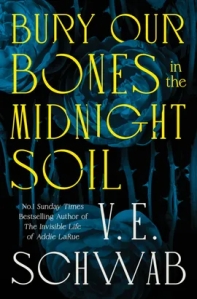
I received a review copy from the publisher. This does not affect the contents of my review and all opinions are my own.
 Bury Our Bones in the Midnight Soil by V.E. Schwab
Bury Our Bones in the Midnight Soil by V.E. Schwab
Mogsy’s Rating (Overall): 4 of 5 stars
Genre: Fantasy, Historical Fiction
Series: Stand Alone
Publisher: Macmillan Audio (June 10, 2025)
Length: 18 hrs and 26 mins
Author Information: Website | Twitter
Narrators: Julia Whelan, Katie Leung, Marisa Calin
Bury Our Bones in the Midnight Soil is not your typical vampire novel. Although V.E. Schwab has always been known for blending her elegant prose with dark themes, this latest release feels like one of her most personal and ambitious works to date. It’s gothic, it’s moody, and very much character-driven, at times giving me a feminist version of Interview with the Vampire vibes. A slow-simmering story spanning centuries, Schwab’s latest focuses on power, womanhood, and the many forms of hunger that drive us.
The story unfolds across three timelines. The first of these begins in 1530s Spain, where we meet a young woman named Maria. Tired of being trapped in a suffocating life of obligation, she devises a plan to escape her insular village by marrying into a noble family, only to discover that her new life is just another kind of prison. Soon, however, she meets a stranger who offers her a different path—one that turns her into something more than human.
Another storyline takes us to 1820s London, where young Charlotte is cast out by her parents after being caught in a scandal involving her childhood best friend. Sent to live with her aunt in the city, she is expected to learn the proper ways of etiquette and quietly earn her way back into the fold. But while observing the older girls prepare for their debuts. Charlote catches the eye of Sabine, an elegant widow and influential Spanish countess who has seamlessly embedded herself into English high society. When Sabine offers to take her under her wing, Charlotte, captivated by the older woman’s charm and worldliness, finds herself quickly swept into her orbit.
The third and final storyline belongs to Alice, who lives in present-day Boston. After a night out on the town, which ends in a romantic encounter with a magnetic stranger, she wakes up alone, confused, and no longer human. But unlike Maria and Charlotte before her, Alice was not given a choice in her transformation. Deeply unsettled and furious at the violation, she sets out on a relentless quest to track down the woman responsible, determined to reclaim her autonomy in a world that now feels disturbingly unfamiliar and dangerous.
Though separated by time and place, each of these three women—Maria, Charlotte, and Alice—all share a common desire: freedom, and a chance to walk the path they choose. Yet as the stories of their lives unfold, it becomes clear that the cost of that freedom is steep and often comes with sacrifice. That said, it didn’t seem as though building an elaborate saga where all the pieces eventually clicked into place was a part of Schwab’s initial goal. Instead, the focus feels more individualistic, allowing each of her characters to fully take over her own storyline, give voice to her own experiences, and offer perspective to her own struggles.
Personally, I found this approach both wonderful and, at times, a little difficult. There’s no question that the author’s writing is at its best when she’s writing character studies and exploring their internal lives. It’s why The Invisible Life of Addie LaRue is one of my all-time favorite books. But essentially giving that richly drawn treatment to no less than three protagonists in a single novel does ask a lot of the reader, and as a result, its structure sometimes breaks the overall flow. It didn’t help that I just recently finished Silvia Moreno-Garcia’s The Bewitching, a book built along a similar framework, featuring three women over multi-generational timelines. And so, for me, it was not surprising that both books also stumbled over some of the same issues, namely the occasional slow spot, interrupted momentum, and a touch of emotional disconnection.
Still, there’s no denying the artistry of Bury Our Bones in the Midnight Soil as a whole. While all three protagonists were powerhouses in their own way, I was most drawn to Maria but the least interested in Alice. And that’s the beauty of the book. Each reader will likely connect with a different woman in the story, for their own reasons. Schwab gives each of her characters their own space to inhabit, trusting that they will speak for themselves, whether it’s Maria expressing her defiance, Charlotte her longing, or Alice her fury.
In the end, I enjoyed Bury Our Bones in the Midnight Soil and found it to be a resonant read. A special mention goes to the audiobook edition, which is truly outstanding. Performed by Julia Whelan, Katie Leung, and Marisa Calin, the audiobook makes each woman’s voice feel distinct and authentic. The narrators capture really well the tone, cadences, and accents of their characters living in their respective eras and locales, making the experience incredibly immersive. If you enjoy audiobooks, this one’s worth a listen. And if you like atmospheric, character-driven vampire tales with an immersive historical backdrop, this novel is worth your time.
![]()
![]()






